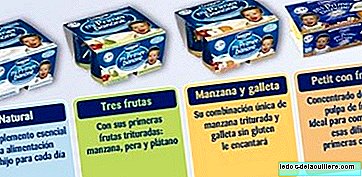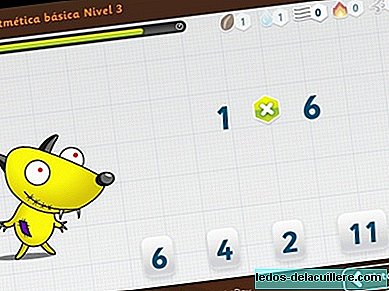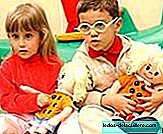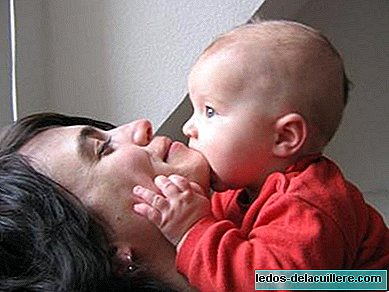
Several years ago since we can find yogurt on the shelves of supermarkets intended for the consumption of babies from six months.
Hundreds (and thousands) of mothers have bought them for their children convinced that it was a suitable and suitable food for them. Even many pediatricians have advised them as dessert or snack.
The truth is "My first yogurt" is an unnecessary food for babies and inappropriate if we consider its ingredients and its composition.
There are several brands and manufacturers, but to talk about these yogurts I will focus on "My first Danone", which is the most representative.
The OCU already talked about them 3 years ago
Three years ago the OCU (Organization of Consumers and Users) published a letter in its health magazine after having analyzed yogurt, which was sold as “made with adapted milk” in which it concluded that "'My first Danone' is nothing but a fermented milk enriched with various substances that, in principle, are already present in the diet of the 6-month-old child".
In the same publication they commented that 22 Primary Care pediatricians denounced the deceptive publicity that Danone made of this product. According to these pediatricians, consumers interpreted that by saying adapted milk the brand was saying “formula adapted for infants”, which led them to buy it thinking that it was better than a normal yogurt.
They claimed that the product was actually made from the same milk used to make any yogurt, but enriched with other substances.
To avoid deception, they requested the change of the name “with adapted milk” to “with enriched milk”, more correct and adjusted to reality.
This was three years ago and Danone, a pioneer brand where they exist and who works daily to renew their products, modified the yogurt using continuation milk.
My first Danone today
Taking a look at the ingredients of “My First Danone - natural flavor” on the product website we see the following:
“Continuous milk 96% (skim milk, cream, total or partially dehydrated skim milk, maltodextrins, vegetable oils, iron and zinc mineral salts and vitamins (A, C, D and E)), sugar (4%), Lactobacillus casei and other lactic ferments. ”
And looking at the data sheet we see that it has 3.6 g of protein per 100 gr.
The benefit of carrying continuation milk is not appreciated
Looking at the ingredients and looking at the data sheet we come to a conclusion: either the benefit of carrying continuation milk is not appreciated or directly does not carry it.
Personally I have the impression that specifying “continuation milk” is nothing more than a marketing strategy at the labeling level, because the use of this milk does not represent a real benefit in protein reduction. I explain:
Cow's milk is not suitable for a baby because it has an excess of protein, more than triple that of breast milk. A baby cannot metabolize a similar amount of protein and that is why they adapt the formulas by decreasing the concentration of cow's milk proteins so that it can be ingested by infants.
Breast milk contains some 0.9 g of protein per 100 ml for the 3.3 g containing cow's milk. That is why they should decrease the concentration.
Starting artificial milk (type 1) contains, for example, 1.2 g (Nativa-1) or 1.4 g (Sanutri Natur 1) per 100 ml.
Continuous artificial milk (type 2) contains, for example, 1.5 g of Nativa-2 or 2.2 g of Sanutri Natur 2 per 100 ml.
By this rule of three "My first Danone", made with continuation milk, it would have to have a quantity of proteins similar to continuation milks (between 1.5 g and 2.2 g according to the examples I have commented to you).
How many proteins can the maximum continuation milk have?
I have given two examples (Nativa and Sanutri) of two milk manufacturers that can be purchased at any establishment, however there are more brands that could have a higher amount of protein and this would make My first Danone not so crazy.
The truth is that most brands, as I said a couple of days ago, are reducing the amount of protein in the continuation (and starter) milks, to try to prevent them from ingesting too many.
In Spain, Royal Decree 867/2008 is in force, which states that continuation preparations must have a maximum of 3.5 g of protein per 100 kcal. If we take into account that the milk must have between 60 and 70 kcal per 100 ml, we obtain a maximum of three 2.45 g of protein per 100 ml.
It is surprising then that "My first Danone" has 3.6 g per 100 ml, an excessively high amount (a normal natural yogurt has, like cow's milk, 3.3 g of protein per 100 ml).
Too many proteins

An infant between 6 and 12 months needs, according to the WHO, about 20 g of protein a day. "My first Danone" of natural flavor contains a total of 4.5 g of protein (yogurt is 125 ml, not 100 ml), 20 g of chicken provide about 4 g of protein and 500 ml of continuation milk contains about 11 g of protein With this we have practically reached the daily recommendation (we add about 19.5 g of protein) and those from vegetables, cereals and fruit are still missing.
Even if the mother offered the baby 375 ml of milk instead of 500 (counting yogurt as a milk of 125 ml) the amount would be excessive.
If we talk about mothers who breastfeed, the amount of protein would remain excessive, but not so much (having breast milk less protein than artificial milk), however we would be replacing breast milk with a lower quality dairy and from cow's milk, running a unnecessary risk of producing allergy or intolerance.
It is estimated that we are giving babies between six and twelve months every day an average of 30 g of protein, much more than they need (if you want to know what consequences an excess of protein can have in the diet I recommend you read the entry : Babies and children take too much protein).
Too much sugar
But everything does not end here. In addition to carrying too many proteins, "My first Danone" natural flavor contains 5 g of sugar (flavors contain 8.75 g), which is the equivalent of a tablespoon of dessert.
A six month old baby should not drink sugar because of the risk of tooth decay, because sugar offers empty calories, which do not provide any nutrients and because it causes them to get used to the sweet taste and then reject other flavors.
Other yogurts
There are other yogurts, such as Nestlé Baby, with practically identical ingredients (and therefore equally undesirable or as the ABC of Central Lechera Asturiana, whose ingredients are:
“Continuation milk 93.7%, partially skimmed milk (1% MG), skimmed milk powder, vegetable oils, mineral salts of iron and zinc, vitamins (A, C, D and E), sugar, fiber, starch, modified from corn, pectin, DHA *, Lactobacilus acidophilus and other lactic ferments. It may contain traces of soy and does not contain Gluten. Proteins 4 g / 100 ml. ”
As you can see, this one has even more protein than Danone's ...
Conclusion
Everybody "My first Danone" children's yogurts are, nowadays, foods not recommended for babies of 6 months. They could be offered to children after twelve months, when they are able to metabolize the amount of protein they contain and when the risk of allergy to cow's milk proteins is lower.
However, at twelve months they can start taking natural yogurts, which are cheaper, have less protein and have no sugar, so they are more recommended.
Breastfed children (between 6 and 12 months) do not need to drink yogurts because they drink better quality breast milk, better nutrients and less protein.
Non-breastfed children (between 6 and 12 months) do not need them because with continuation milk (type 2) they already take too much protein and as artificial food artificial milk is more recommended than a yogurt of this type, which contains sugar and cream .
Photos | Clubpadres.com, Digital Eye (Jackiejuan), Flickr (bdunnette)
In Babies and more | Complementary feeding: milk and its derivatives, Prohibit an announcement of Actimel in the United Kingdom because it is considered misleading, My first Danone versus ABC of Central Lechera Asturiana












